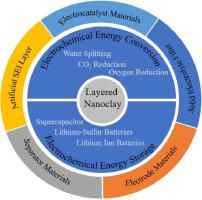EnergyChem ( IF 25.1 ) Pub Date : 2021-09-17 , DOI: 10.1016/j.enchem.2021.100062 Caihong Yang 1, 2 , Ruijie Gao 1, 2 , Huaming Yang 1, 2, 3

|
To meet the growing energy demands in a low-carbon economy, the development of new materials that improve the efficiency of energy storage and conversion systems is essential. Layered nanoclay offers opportunities in energy storage and conversion applications owing to their great reserves, high surface areas, multi-pore structure and other unique physical and chemical properties. These characteristics provide opportunities and advantages for the application of layered nanoclay in electrochemical energy. In this review, we summarized the structure, classification, modification method and properties of nanoclays, along with discussed their applications as electrodes, electrolytes filler, separators, artificial solid electrolyte interface (SEI) layer in rechargeable batteries and supercapacitors (SCs), and as catalysts in water splitting, CO2 reduction and oxygen reduction. Finally, we concluded the current problems of layered nanoclay in energy storage and conversion, and pointed out the possible future development trend and strategy, which increases their contribution in electrochemical energy applications.
中文翻译:

层状纳米粘土在电化学能源中的应用:现状与未来
为了满足低碳经济中不断增长的能源需求,开发能够提高能量存储和转换系统效率的新材料至关重要。层状纳米粘土由于其储量大、表面积大、多孔结构和其他独特的物理和化学性质,为能量存储和转换应用提供了机会。这些特性为层状纳米粘土在电化学能源中的应用提供了机会和优势。在这篇综述中,我们总结了纳米粘土的结构、分类、改性方法和性质,并讨论了它们在可充电电池和超级电容器 (SC) 中作为电极、电解质填料、隔膜、人造固体电解质界面 (SEI) 层的应用,以及作为水分解催化剂,CO2还原和氧还原。最后,总结了层状纳米粘土在储能和转换中存在的问题,并指出了未来可能的发展趋势和策略,增加了其在电化学能源应用中的贡献。


























 京公网安备 11010802027423号
京公网安备 11010802027423号